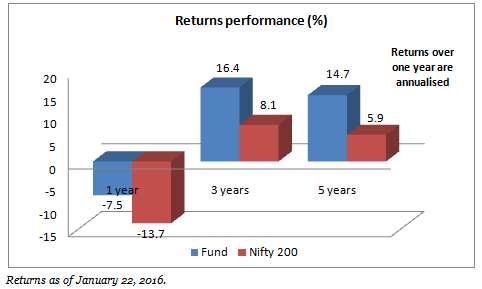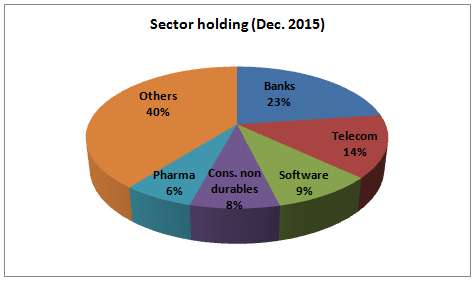For those looking for a quality tax-saving fund as the time to make Section 80C investments nears a close, BNP Paribas Long Term Equity is a good choice. It has proven itself during market downturns, it centres its portfolio around large-cap stocks, it places importance on valuations and company management, and has, to round it all off, a good performance record. The fund made it to our Select Funds list about a quarter ago.

BNP Paribas Long Term Equity climbed up the performance curve over the past five years, before which it was a middling performer. A fund manager change in 2011 appears to have helped turn things around. Across the one, three, and five-year periods, the fund has remained in the top two quartiles among tax-saving funds. It has beaten its benchmark, Nifty 200, by a margin of 6 to 8 percentage points in these periods.
It is also consistent – rolling three-year returns every day over the past five years show that the fund delivered better returns than the Nifty 200 a good 88 per cent of the time. BNP Paribas Long Term Equity requires a moderate risk appetite.
Containing volatility
During the bearish 2011 market, as well as the aimless 2013 market, the fund did better than its category average, indicating a good record at keeping downsides in check. On this count, the fund is unmatched by peers, except for Axis Long Term Equity. This is a key positive, given the turbulent markets now and the probability that they will remain so for this year.
In the bullish 2014 market, however, BNP Paribas Long Term Equity didn’t match up to peer average, though it comfortably beat its benchmark. This was due to according the flamboyant mid-cap stocks a lower allocation. Peers such as Reliance Tax Saver and Birla Sun Life Tax Relief 96, which were huge gainers in that run, had nearly double the mid-cap allocation. Large-cap stocks (those with a market capitalisation of Rs. 15,000 or more) have accounted for around 70 per cent of BNP Paribas Long Term Equity’s portfolio over the past three years.
The fund can thus protect losses during bad times, but may not offer flashy returns during sharp market upswings. Its volatility is much lower than the category average, while also maintaining its risk-adjusted returns above the average.
Sectors and stocks
The fund tends to pick growing companies at reasonable prices, paying special heed to quality of management, and the strength of the business. It also takes a longer-term view on the growth potential of sectors. Most funds from the BNP Paribas stable follow similar strategies. Banking is the top sector weight currently, and has been so from the second half of 2014. Here, the fund holds private sector players such as HDFC Bank, Kotak Mahindra Bank, IndusInd Bank, and Axis Bank, while pruning exposure to poor performers such as ICICI Bank, Federal Bank and State Bank of India.

Next, unlike most peers, this fund has not relied heavily on the auto and auto ancillary sectors. Instead, it is playing the consumption theme through telecom, consumer non-durables, hotels, and logistics; it has primarily chosen market leaders, or large players in these sectors. Exposure to telecom has been pruned a bit over the past couple of months, possibly due to the latest entrant in the fray and its effect on existing players, though the sector still holds promise.
Holding in the staple software sector has seen major ups and downs over the past three years, but share has been maintained at around 8-9 per cent over the past several months. Here, the fund holds slightly off-beat stocks in Just Dial and Info Edge, though the former stock has had a particularly bad run. While the defensive pharmaceuticals sector features among the top five, holding here was cut over the past few months.
The fund is managed by Shreyash Devalkar, and has an asset size of Rs. 422 crore. The fund was formerly known as BNP Paribas Tax Advantage Plan (ELSS). Note that as a tax-saving fund under the Section 80C umbrella, investments are subject to a lock-in of three years. If investments are being made through systematic plans, each instalment will be locked for three years.
FundsIndia’s Research team has, to the best of its ability, taken into account various factors – both quantitative measures and qualitative assessments, in an unbiased manner, while choosing the fund(s) mentioned above. However, they carry unknown risks and uncertainties linked to broad markets, as well as analysts’ expectations about future events. They should not, therefore, be the sole basis of investment decisions. To know how to read our weekly fund reviews, please click here.







Thanks for the inputs but if you observe Tata Tax saving fund growth has better results than BNP LT EF . Could you please provide your observation??
Hi Rohit,
The Tata fund’s returns are better than the BNP fund in the one year period. In the five years, the BNP fund has managed better. The BNP fund is also relatively more consistent, again over the past five years. Tata India Tax Savings also has a higher allocation to mid-cap stocks than BNP LTE, so it would require a higher risk appetite.
Thanks,
Bhavana
Thanks for the inputs but if you observe Tata Tax saving fund growth has better results than BNP LT EF . Could you please provide your observation??
Hi Rohit,
The Tata fund’s returns are better than the BNP fund in the one year period. In the five years, the BNP fund has managed better. The BNP fund is also relatively more consistent, again over the past five years. Tata India Tax Savings also has a higher allocation to mid-cap stocks than BNP LTE, so it would require a higher risk appetite.
Thanks,
Bhavana
Nice article.
Nice article.